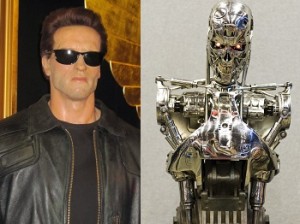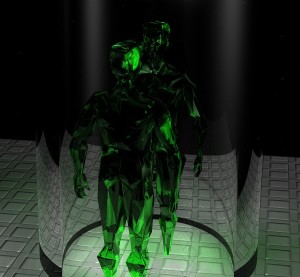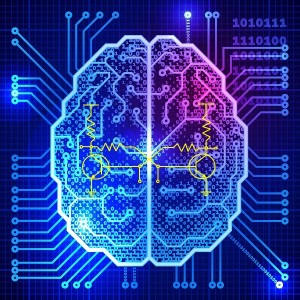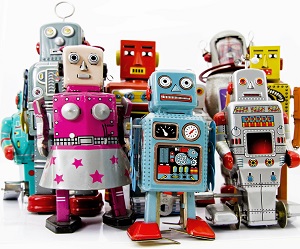21 May Modeling After a Fashion
Perennial Image Problems
 Artificial Intelligence has an image problem. Yes, there are cybernetic characters like R2D2, C3P0 and Commander Data whom we love, but some products built using AI techniques have the dubious reputation of being useful but not entirely dependable. Think of songs sung about Sirius Cybernetics Teleporter products (see lyrics below). It is possible that the non-deterministic aspects of many AI technologies have led to this reputation.
Artificial Intelligence has an image problem. Yes, there are cybernetic characters like R2D2, C3P0 and Commander Data whom we love, but some products built using AI techniques have the dubious reputation of being useful but not entirely dependable. Think of songs sung about Sirius Cybernetics Teleporter products (see lyrics below). It is possible that the non-deterministic aspects of many AI technologies have led to this reputation.
In upcoming posts, I will explore some of the techniques used in AI products: Expert Systems, image recognition systems, and other AI technologies that do not incorporate neural networks. Biological neural networks are, of course, the subject of Section 3, and artificial neural systems are covered in Section 4. This section is by no means an exhaustive analysis of these techniques; it does, however, build on the information presented in the previous sections, providing a framework for describing the types of algorithms used to build systems that model cognitive processes.
| Understanding Context Cross-Reference |
|---|
| Click on these Links to other posts and glossary/bibliography references |
|
|
|
| Prior Post | Next Post |
| Cybernetic Modeling for Smarty-Pants | What Constitutes a Brain |
| Definitions | References |
| non-determinism AI | Adams 1986 |
| neural network algorithms | Reference List |
| modeling cognition process | Space Odyssey |
A fictional company referenced in Hitchiker’s Guide to the Galaxy, Sirius Cybernetics, manufactures convenience products such as teleporter machines that take people apart atom by atom and fling them across galaxies to be reassembled at their destinations. Alas, there are apparently some possible side effects, as reflected in this little ditty:
 I teleported home one night
I teleported home one night
with Ron and Sid and Meg;
Ron stole Meggie’s heart away
and I got Sidney’s leg. (Adams, 1986)
Fortunately, AI techniques are not running teleporters yet, but there are cars on the highways and byways that are completely automated. This is a fantastic development, demonstrating that, even in complex scenarios with many constantly changing variables, computers can think and act pretty well. Let’s start looking at how.
Mechanical Brains
What is the mechanical brain paradigm?
Scientists have developed excellent information-processing tools (computers) that extend our ability to retain, access and use the enormous and ever-growing body of knowledge we possess. These computers are designed on the basis of a combination of mechanical principles and automata theory. The combined processes are called artificial intelligence.
Automata theory is a set of principles used to manipulate symbols to produce desired results. Manipulating symbols is how all computers process information. It is likely that human brains also manipulate symbols, such as words and images, to store and process knowledge. An analogy can thus be drawn between automata theory and cognitive science.  The extension of this analogy is to treat computers as mechanical devices that imitate some cognitive processes. A simplification of the analogy is to call computers mechanical brains.
The extension of this analogy is to treat computers as mechanical devices that imitate some cognitive processes. A simplification of the analogy is to call computers mechanical brains.
The golden circuit you see superimposed on this outline of your brain is a flip-flop. The processor in your computer has millions of them. Your brain has trillions.
Controversy?
Expressions such as “mechanical brain” and “artificial intelligence” may excite controversy. After all, they raise serious philosophical and even theological questions. The potential (and potential danger) of developing genuine “thinking” machines has been romantically portrayed in many works, including 2001 – A Space Odyssey. The theme song of that movie, “Thus Spake Zoroaster,” reflects the personification or deification of the machine or its creator.
 If 2001 left you unsettled, how about the Terminator movies? The story line of that collection is that machines get really smart and try to take over the world, or major parts of it. Technologies like time travel and fluid metal machinery portrayed in the Terminator movies and other sci-fi films may seem well beyond our reach, but they also leave unsettling questions.
If 2001 left you unsettled, how about the Terminator movies? The story line of that collection is that machines get really smart and try to take over the world, or major parts of it. Technologies like time travel and fluid metal machinery portrayed in the Terminator movies and other sci-fi films may seem well beyond our reach, but they also leave unsettling questions.
I do not plan to examine the likelihood of technology ever reaching the complex level of biological systems (artificial life). Instead, I plan to explain my universal information theory and a technology that uses nature as a model to improve functional approaches to mechanical problem solving. We’ll tackle brain tasks one at a time.
So you don’t believe in Star Wars, huh? Tell me this: Did the moon landing ever really occur? With which of the cybernetic characters in this blog would you feel most comfortable?
| Click below to look in each Understanding Context section |
|---|








